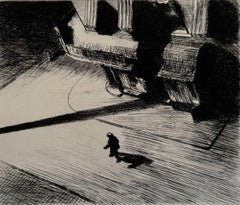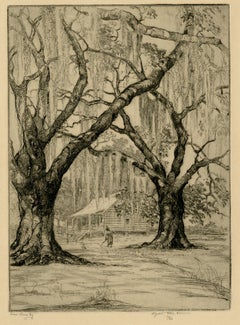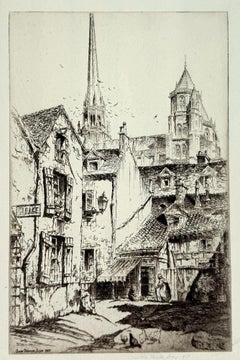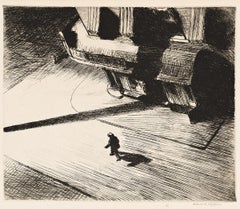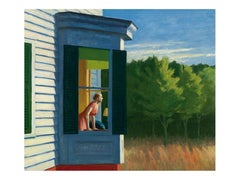Edward Hopper Figurative Prints
Born in Nyack, New York, along the Hudson River, Edward Hopper began to study art in the local schools before seeking instruction in commercial art in New York City in 1899. From 1900 to about 1906 he studied at the New York School of Art under Robert Henri and Kenneth Hayes Miller, both of whom urged their students to concentrate on modern subjects.
Among Hopper's fellow students were George Bellows, Rockwell Kent, and Guy Pene du Bois. Between 1906 and 19l0, Hopper made three European visits of several months each, spending most of his time in Paris. Living quietly with a French family, he did not study in an art school but painted on his own. The artists he looked at and admired were those Henri had suggested — Goya, Manet, Degas, Sisley and Pissarro. The latter two showed up as the first major influences of his street views of Paris.
Back home in these same years, Hopper was painting aspects of the native scene that few artists had attempted. Although the Ashcan group — Henri, John Sloan, William Glackens, George Luks and Everett Shinn — concentrated on the visual aspects of the metropolis, Hopper was the first to capture the inner feelings of the city and suburban dwellers themselves. Railroad Train (Addison Gallery of Art) and The El Station (Whitney Museum of American Art), both of 1908, were transitional works showing Hopper's movement away from Henri's dark tonalities of the period toward outdoor light and color effects. Little recognition came his way at first and Hopper was forced to concentrate on illustration work to make a living.
Hopper stopped painting completely for a time and, around l9l9, took up etching, capturing on the plate his concepts of everyday life in America that contained the essentials of his later paintings: uncompromising realism, absolute simplicity of statement and a sense of mood that raised it above mere naturalism. His etchings were accepted in major exhibitions and won prizes for the artist; this encouragement led him to take up painting again, both in oil and watercolor, a medium in which he proved to be a master.
In 1927, a showing of his oils at the Rehn Gallery in New York definitely established Hopper's reputation. From about 1920 on, a number of younger artists including Thomas Hart Benton, Charles Burchfield, Reginald Marsh, John Steuart Curry, Grant Wood joined Hopper in a nationalist school dedicated to painting the native scene in a more or less naturalistic style. Hopper's masterpieces of the 1920s and 1930s: House by the Railroad (1925, Museum of Modern Art), Automat (1927, Des Moines Art Center) and Lighthouse at Two Lights (1929, Metropolitan Museum of Art) formed the core of this American Scene movement.
Hopper's vision was unique. The people inhabiting his city and suburban scenes are lonely, anonymous, temporary inhabitants of sometimes inhospitable environments. When there is no human element, he transfers these qualities to the architecture or even to the landscape itself, using intense light to infuse human emotion.
Find original Edward Hopper paintings and prints on 1stDibs.
(Biography provided by Lincoln Glenn)
1920s American Modern Edward Hopper Figurative Prints
Etching
Early 20th Century American Modern Edward Hopper Figurative Prints
Archival Paper, Drypoint, Etching
Early 20th Century American Modern Edward Hopper Figurative Prints
Handmade Paper, Etching
1920s American Modern Edward Hopper Figurative Prints
Handmade Paper, Laid Paper, Etching, Aquatint
Mid-20th Century American Modern Edward Hopper Figurative Prints
Handmade Paper, Etching
Mid-20th Century American Modern Edward Hopper Figurative Prints
Laid Paper, Etching, Aquatint
Mid-20th Century American Modern Edward Hopper Figurative Prints
Laid Paper, Handmade Paper, Etching
1920s American Modern Edward Hopper Figurative Prints
Handmade Paper, Laid Paper, Etching, Aquatint
Early 20th Century American Modern Edward Hopper Figurative Prints
Etching, Laid Paper
Early 20th Century American Modern Edward Hopper Figurative Prints
Handmade Paper, Etching
Early 20th Century American Modern Edward Hopper Figurative Prints
Handmade Paper, Etching, Aquatint
Mid-20th Century American Modern Edward Hopper Figurative Prints
Handmade Paper, Etching
Mid-20th Century American Modern Edward Hopper Figurative Prints
Handmade Paper, Etching, Aquatint
1920s Realist Edward Hopper Figurative Prints
Etching
2010s Edward Hopper Figurative Prints
Paper
1920s American Modern Edward Hopper Figurative Prints
Etching
